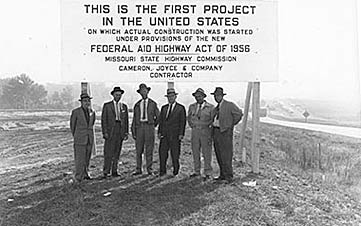A Brief History of the Federal Gasoline Tax
The government has been taxing our fuel for over 80 years—and right from the get-go, the money was going to things other than roads and bridges.

As Congress considers raising the federal tax on gasoline for the first time since 1993, consider highlights from a history of the tax prepared by the Congressional Research Service (CRS). In 1911, just three years after the Model T was introduced, Oregon became the first state to tax motor fuels. By 1932, every state and the District of Columbia had followed suit. And in 1932, the feds got in on the act.
1932
A temporary 1-cent-a-gallon federal tax is imposed. It is not dedicated to building roads but rather to deficit reduction in the midst of the Great Depression. It is scheduled to expire in 1934.
1933
Congress votes to extend the tax and increase the rate to 1.5 cents a gallon.

Sign up for Kiplinger’s Free E-Newsletters
Profit and prosper with the best of expert advice on investing, taxes, retirement, personal finance and more - straight to your e-mail.
Profit and prosper with the best of expert advice - straight to your e-mail.
1934
When Prohibition ends (so the feds can again tax booze), the gas tax falls back to 1 cent a gallon, where it stays until 1940.
1940
In anticipation of World War II, the tax rate is hiked to 1.5 cents a gallon through June 1945. Later, it is made permanent at that level.
1951
To help pay for the Korean War, Congress boosts the gas tax to 2 cents a gallon.

1956
Congress creates the Highway Trust Fund, increases the federal gas tax to 3 cents a gallon and dedicates 100% of the revenue to the Trust Fund to help pay for the interstate highway system.
1959
Congress pushes the tax to 4 cents a gallon.
1983
Lawmakers add a nickel a gallon, setting the rate at 9 cents a gallon, with 1 cent dedicated to mass transit projects.
1990
An additional 5 cents a gallon is added, bringing the tax to 14 cents a gallon. Half of the increase is dedicated to highways, the other 2.5 cents aimed at deficit reduction (the same goal as the original tax in 1932).
1993
Congress adds 4.3 cents a gallon to the gasoline tax, with the added revenue dedicated to deficit reduction. With the addition of the 0.1-cent-a-gallon levy to fund the leaking underground storage tank trust fund the federal tax rose to 18.4 cents a gallon. That’s where it stands today. Since 1997, the full federal gasoline tax has gone to the Highway Trust Fund.
Get Kiplinger Today newsletter — free
Profit and prosper with the best of Kiplinger's advice on investing, taxes, retirement, personal finance and much more. Delivered daily. Enter your email in the box and click Sign Me Up.

-
 Trump Dials Back Most Tariffs but Targets China
Trump Dials Back Most Tariffs but Targets ChinaThe Kiplinger Letter Wall Street hopes that higher tariffs on most countries are on hold for good. But the trade war between the U.S. and China is heating up.
By Jim Patterson
-
 You’re Probably Not Covered for These 6 Common Home Disasters
You’re Probably Not Covered for These 6 Common Home DisastersHome insurance doesn’t cover everything. Learn which disasters require extra coverage — and how to protect your home before it’s too late.
By Jacob Wolinsky
-
 Roth IRA Contribution Limits for 2025
Roth IRA Contribution Limits for 2025Roth IRAs Roth IRA contribution limits have gone up. Here's what you need to know.
By Jackie Stewart
-
 Four Tips for Renting Out Your Home on Airbnb
Four Tips for Renting Out Your Home on Airbnbreal estate Here's what you should know before listing your home on Airbnb.
By Miriam Cross
-
 Five Ways to a Cheap Last-Minute Vacation
Five Ways to a Cheap Last-Minute VacationTravel It is possible to pull off a cheap last-minute vacation. Here are some tips to make it happen.
By Vaishali Varu
-
 How to Figure Out How Much Life Insurance You Need
How to Figure Out How Much Life Insurance You Needinsurance Instead of relying on rules of thumb, you’re better off taking a systematic approach to figuring your life insurance needs.
By Kimberly Lankford
-
 Amazon Big Deal Days Is Coming! We’ve Got All the Details
Amazon Big Deal Days Is Coming! We’ve Got All the DetailsAmazon Prime To kick off the holiday season with a bang, Amazon Big Deal Days runs Tuesday, October 8 and Wednesday, October 9.
By Bob Niedt
-
 How to Shop for Life Insurance in 3 Easy Steps
How to Shop for Life Insurance in 3 Easy Stepsinsurance Shopping for life insurance? You may be able to estimate how much you need online, but that's just the start of your search.
By Kaitlin Pitsker
-
 Five Ways to Shop for a Low Mortgage Rate
Five Ways to Shop for a Low Mortgage RateBecoming a Homeowner Mortgage rates are high this year, but you can still find an affordable loan with these tips.
By Daniel Bortz
-
 Retirees, It's Not Too Late to Buy Life Insurance
Retirees, It's Not Too Late to Buy Life Insurancelife insurance Improvements in underwriting have made it easier to qualify for life insurance, which can be a useful estate-planning tool.
By David Rodeck